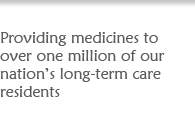|
Testimony of the Long Term Care Pharmacy Alliance before the Ohio Department of Job and Family Services on proposed rule 5101:3-9-08 -- long-term care pharmacy best practices management incentive payment program.
delivered by Joseph R. Sabino, MS, RPh
Executive Director, NCS Healthcare of Columbus, Ohio
September 24, 2002
Thank you for this opportunity to testify before you today on the department's plan to initiate a long-term care pharmacy best-practices management-incentive payment program, also known as the "Catalyst" program.
My name is Joe Sabino and I am the executive director of the Columbus operations of NCS Healthcare and a former president of the Ohio Board of Pharmacy. My company, NCS HealthCare, is based here in Ohio and focuses on providing quality pharmacy care to the frail elderly in nursing homes across the country. We've operated with Ohio as our base since 1986 and have three locations, 402 employees in Ohio and we care for nearly 21,000 elderly in Ohio and over 200,000 across the country.
I am here representing the Long Term Care Pharmacy Alliance, which represents the major national operators of long-term care pharmacies. LTCPA's five member companies serve nearly 70 percent of the nursing-home residents in Ohio - in all, more than 70,000 frail elderly and disabled patients.
LTCPA believes the Catalyst program is flawed and potentially could harm the vulnerable patients who rely on long-term care pharmacies to provide them appropriate pharmacy care. The main problem with the Catalyst program is that it creates incentives for withholding appropriate pharmaceutical care by rewarding pharmacies solely for holding down costs. In other words, Catalyst elevates cost considerations over clinical considerations.
I'd like to note that long-term care pharmacies are already helping the Ohio Medicaid program control costs. The average amount of our Medicaid paid claims is less than the average amount of paid claims from retail pharmacies, in large part due to our aggressive generic-substitution and therapeutic-interchange programs, where we substitute lower-cost generic and brand-name drugs for higher-cost drugs whenever clinically appropriate.
In addition, the drug regimen reviews conducted by our consultant pharmacists have been credited with lowering the annual nationwide costs of drug-related problems in long-term care facilities from an estimated $7.6 billion to $4 billion. At the same time, these activities are estimated to have improved therapeutic outcomes by 43 percent.
Finally, the Medicare prospective payment system implemented in the late 1990s for nursing-home care already provides us a significant incentive to control drug spending. Since nursing facilities now receive per-diem payments that must cover all costs of services furnished to beneficiaries under Part A of the Medicare program, including the costs of medication and medication-related services, physicians and long-term care pharmacies are under enormous pressure from their client nursing homes to hold down the costs of drug therapies. Since most nursing facilities serve both Medicare and Medicaid beneficiaries, Medicaid indirectly benefits from pharmacies' efforts to control drug costs for beneficiaries covered by Medicare Part A.
As you can see, long-term care pharmacies already engage in practices that save money for Ohio Medicaid. While we are not averse to trying to do more to achieve savings, particularly if we are compensated appropriately for our efforts, we don't believe that the Catalyst program provides the proper incentives.
The Catalyst program's focus on cost considerations over clinical concerns suggests an assumption that nursing-home residents are over-medicated or are receiving higher-cost medications when lower-cost medications will do.
As mentioned earlier, long-term care pharmacies already have significant incentives to substitute lower-cost medications for higher-cost drugs whenever clinically appropriate. However, many of the newer and more expensive drug therapies are more appropriate for the frail elderly.
For instance, while older anti-psychotic drugs mainly reduced positive symptoms of schizophrenia such as hallucinations and delusions, the newer antipsychotic drugs have demonstrated improved efficacy against both positive symptoms and negative symptoms, such as apathy and social withdrawal. The newer drugs also have fewer side effects, which is very important in treating frail patients such as nursing-home residents.
In short, the newer antipsychotic drugs may be more expensive, but they are also more effective and appropriate for the frail elderly. Unfortunately, the Catalyst program would create incentives to avoid newer and more expensive drugs that may be the most clinically appropriate for our vulnerable patient population.
Moreover, there is little evidence that nursing-home residents are over-medicated. For instance, the federal HHS Office of Inspector General (OIG) recently found that 85 percent of nursing-home residents' use of psychotropic drugs is medically appropriate. The OIG also found that nearly all residents have the potential to benefit functionally from their drug therapy and are using the drugs within Medicare guidelines for appropriate use. Furthermore, a number of studies suggest many residents suffering from common disorders like depression, hypertension and incontinence are actually under-medicated.
Since the sickest patients often require the most pharmaceutical treatment, the Catalyst program's design ultimately will encourage pharmacies to avoid serving nursing homes with the highest acuity levels, such as facilities that treat significant numbers of patients with AIDS or who require intensive services such as dialysis and total parenteral nutrition. While engaging in such adverse selection would certainly earn pharmacies significant incentive payments, it could also create access problems for Medicaid beneficiaries in the state.
Furthermore, to the extent that failure to receive optimal drug therapies contributes to a decline in a nursing-home residents' health status, or an increase in side effects or other medication-related problems, the Catalyst program might result in an increase in laboratory tests, psychiatric consultations, and hospital admissions. This might ultimately cost Ohio Medicaid more than the projected savings that the Catalyst program can be expected to generate.
Finally, the Catalyst program provides little incentive to pharmacies that are already saving the state money relative to industry averages. In other words, companies who are already doing the most to help the state control costs have the least to gain through the program, and vice versa. If Ohio truly believes that there is significant savings to be achieved from "inefficient" pharmacies, it ought to find a way to eliminate that inefficiency without subjecting all of pharmacy to a significant rate cut and then giving money back in the form of "incentive" payments to the least efficient providers.
In any case, there are better ways for Ohio to control prescription drug spending than to implement the "Catalyst" program. LTCPA and its member companies are willing to work with Ohio to develop strategies that ensure pharmaceutical care for the frail elderly that are both cost-effective and clinically appropriate.
We strongly believe that Ohio should not award financial incentives without measuring a company's performance against a set of quality indicators, thereby ensuring that companies are not manipulating their quality of service to maximize financial bonuses. Without such quality benchmarks, the Catalyst program will simply provide incentives to compromise the overall quality of pharmacy care for the sake of a financial bonus.
While we note that Ohio Medicaid will evaluate the program's impact on quality of pharmacy care in fiscal year 2005, we have no idea what indicators you will use to judge quality. LTCPA would be happy to work with Ohio Medicaid to develop a set of appropriate quality indicators accompanied by financial incentives that encourage the optimization of pharmacy care for the frail elderly and disabled.
Finally, please keep in mind that most of the long term care pharmacy community in Ohio does not support the Catalyst program as currently crafted. The members of LTCPA -- consisting of Kindred Pharmacy Services, NCS Healthcare, NeighborCare, Omnicare and PharMerica -- have grave concerns about Catalyst, and the association itself opposes the program. Given that LTCPA members serve nearly 70 percent of the nursing-home residents in Ohio, we were disappointed that Ohio Medicaid never made a concerted effort to work with us to address our concerns, and instead issued an emergency rule to implement this program.
As businesses that provide healthcare services, long-term care pharmacies have obligations both to our investors and to the patients we serve. The pharmacists we employ also have ethical responsibilities to fulfill. By elevating cost considerations over clinical concerns, the Catalyst program pits profits against patient care. If you instead create real incentives for quality care, not just cost-conscious care, I believe that long-term care pharmacies will be disposed much more favorably to this program.
We appreciate your willingness to consider our objections to the proposal. We hope you will pull back this emergency rule and work with us to improve the Catalyst program in a way that promotes more appropriate incentives for providing healthcare that is both cost-effective and of the highest possible quality.
|


